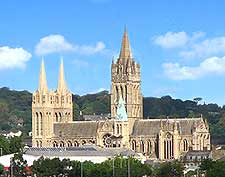Truro History Facts and Timeline
(Truro, Cornwall, England, UK)

A settlement has existed in Truro since prehistoric times. However, it wasn't until the construction of a castle by the Normans that a small port town grew up.
Excavations have revealed history showing that the castle was built on the site currently occupied by the Courts of Justice. The town's name is thought to derive from 'Tri-veru', meaning the 'three rivers' that form the Truro River. In the 12th century, a Royal Charter was granted to the town by Henry III's brother, Earl Richard of Cornwall.
By the 14th century, Truro had become an important port town, with several small quays. It was also one of Cornwall's principal stannary (tin mining) towns. Here, copper and tin were assayed and then transported by river to the sea. A tax was levied on each ingot of metal before export and a Stannary Court was set up. However, such prosperity was to be dealt a severe blow during the Black Death in the late 14th century. Many townsfolk left Truro to its fate and the town fell into neglect.
Truro in Early Modern Times
By the 16th century, Truro had recovered and was thriving once again. The granting of a Charter to the town by Elizabeth I brought some measure of self-government, including the election of a mayor. Truro Grammar School was founded in 1547. During the English Civil War, a mint was briefly established in the town to strike coinage to aid the Royalist cause.
During the two centuries that followed, Truro became quite a bustling industrial centre, dealing in tin smelting, pottery, tannery and wool making. At some point in the 18th century, The port moved from its original medieval site, in the shadow of the town's castle, to Lemon Quay. The quay was named after the prominent mining magnate and Member of Parliament, Sir William Lemon.
Modern Truro
The Industrial Revolution and rising tin prices in the 19th century allowed Truro to really flourish. Wealthy tin mine owners built elegant town houses here, including the Georgian buildings erected in the main residential area, Lemon Street. Indeed, Truro acquired something of a reputation as being the 'London of Cornwall'. To accommodate the arrival of such high society, a theatre was built in the town, along with an Assembly Rooms in which monthly balls were held.
A direct rail connection to
London was opened, helping to raise the town's popularity even further. In 1876, the Bishopric of Truro Bill was passed, allowing the appointment of a bishop, one Edward White Benson. That same year, Queen Victoria granted Truro city status. It still remains the only city in Cornwall. In 1890, the foundation stones of a new cathedral were laid on the site of the 16th-century church of St. Mary the Virgin.
As the 20th century dawned, the mining industry started to wane. Nearby
Falmouth grew up as a port, sending Truro's into something of a decline. In the 1920s, Lemon Quay was covered over - it has since been redeveloped as a Piazza. The city of Truro took on a new role, as a commercial and administrative centre for the region.
 A settlement has existed in Truro since prehistoric times. However, it wasn't until the construction of a castle by the Normans that a small port town grew up.
A settlement has existed in Truro since prehistoric times. However, it wasn't until the construction of a castle by the Normans that a small port town grew up.